Wer auf Bonaire Urlaub macht, möchte weder Kultur noch Strände, sondern TAUCHEN! Die Haupt-Sehenswürdigkeiten der kleinen Karibik-Insel liegen unter Wasser, doch auch an Land zahlt sich der eine oder andere Abstecher aus!
Die Tauchgründe um Bonaire zählen zu den besten weltweit und die Umweltorganisation STINAPA sorgt mit dem Bonaire Marine Park dafür, dass dies auch so bleibt. Dementsprechend liegen die meisten Sehenswürdigkeiten von Bonaire unter Wasser und setzen zum Entdecken zumindest Taucherbrille und Schnorchel voraus. Tauchen oder Schnorcheln ist beim Urlaub auf Bonaire also ein absolutes Muss!
Auf dem Landweg ist die Insel innerhalb weniger Tage erkundet. Die Stimmung auf Bonaire ist wunderbar relaxed, Stress ist – typisch für die Karibik – ein absolutes Fremdwort. Vor allem Mittags, wenn das Thermometer über 30°C klettert, flüchten sich die meisten Einheimischen nach drinnen – oder ins Meer!
Wer seinen Kopf nicht so gern unter Wasser versenkt, sondern das karibische Flair lieber auf dem Trockenen oder zumindest mit dem blauen Himmel in Sicht genießen möchte, findet die typischen Bilderbuch-Strände mit weißem Sand und türkisem Meerwasser vor allem in Nordwesten von Bonaire beim Washington Slagbaai Nationalpark. Surfer und Familien mit Kinder sind am besten in der Lac Bay im Süden von Bonaire aufgehoben.
Tipp: Wer nach dem Tauchurlaub noch ein paar entspannende Tage am Strand anhängen möchte, findet auf der Nachbarinsel Aruba einige Strandparadiese, die zu den schönsten der Welt gehören.
Inhaltsverzeichnis
Tauchgründe um Bonaire
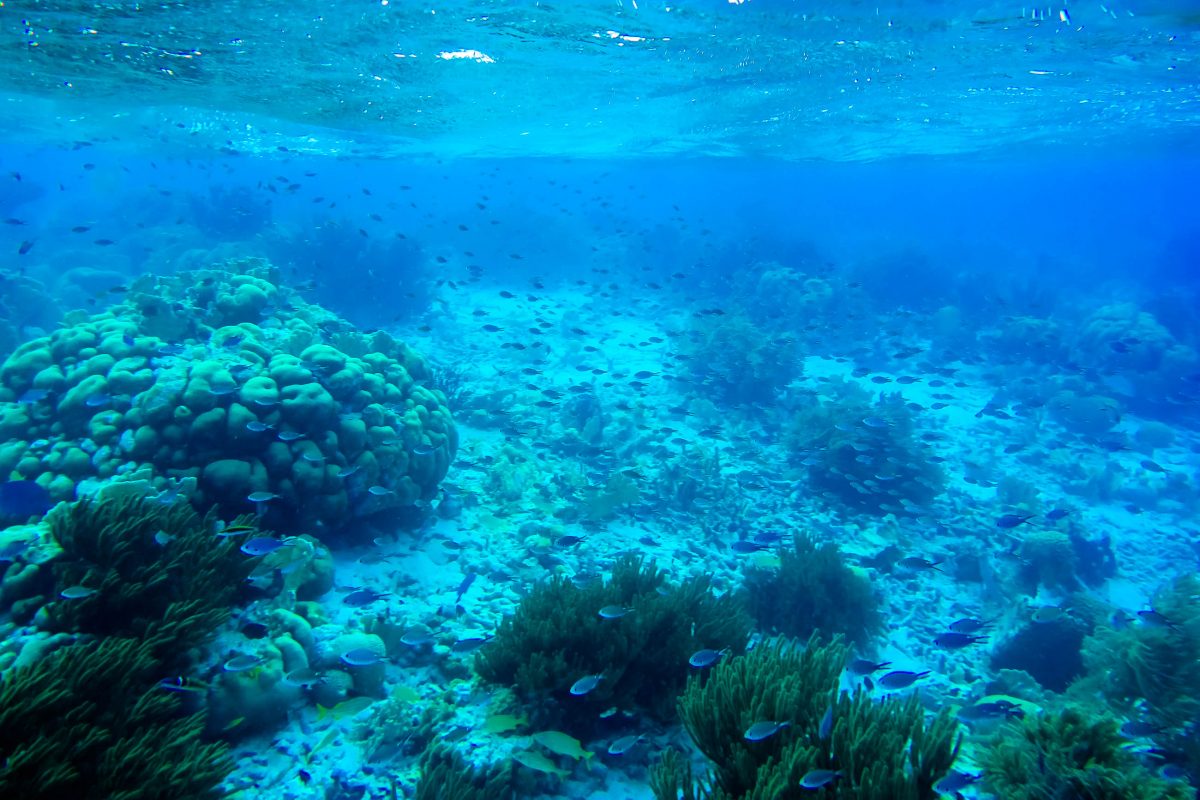
Rund um die Insel liegen einige der schönsten Tauchgründe der Welt, die zur Gänze unter Naturschutz stehen. Die 63 offiziellen Tauchgründe lassen mit einer Wassertemperatur von knapp 30°C keine Wünsche offen. Sie begeistern Taucher und Schnorchler mit reich bevölkerten Korallenriffen, Schiffswracks und Sichtweiten bis zu 40 Metern.
Artikel: Die 10 schönsten Tauch-Spots auf Bonaire
Fotogalerie: Tauchen und Schnorcheln auf Bonaire
Mangrovenwälder von Lac Bay
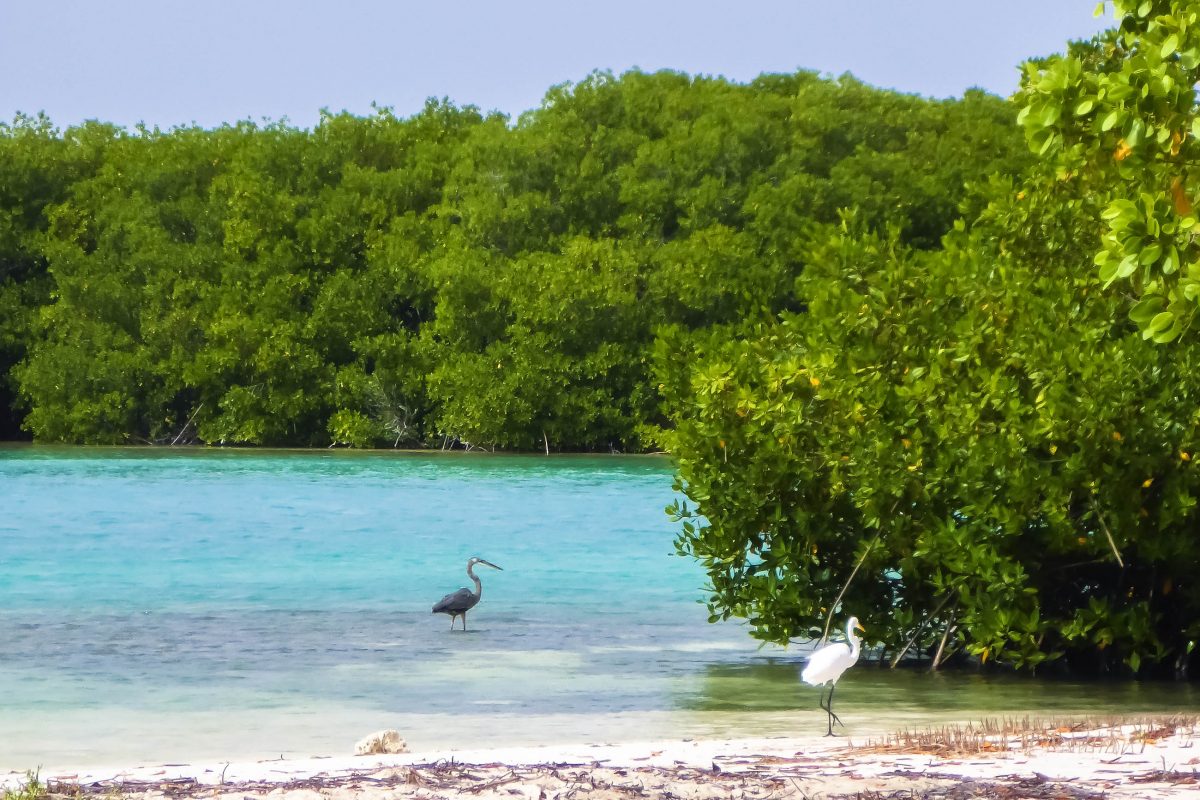
Bei Lac Bay im Süden Bonaires liegt die größte Lagune der niederländischen Antillen, an deren Ufern dichte Mangrovenwälder gedeihen. Die idyllische Heimat von unzähligen Fischen, (völlig harmlosen) Mangrovenquellen, Muscheln und Seevögeln kann mit dem Kajak erkundet werden. Auch hier kann man übrigens tauchen – in einer ganz eigenen Welt, in der statt Korallen und Muscheln Äste und Blätter am Meeresgrund liegen.
Artikel: Mangrovenwälder bei Lac Bay
Fotogalerie: Mangrovenwälder bei Lac Bay
Lagune Lac Bay

Auch die Lagune von Lac Bay selbst ist natürlich einen Besuch wert. Hier findet man die schönsten Sandstrände auf Bonaire mit besten Voraussetzungen für einen klassischen Strandtag. Der flach abfallende Strand lockt Familien mit Kindern ans Wasser und weiter draußen zischen die Segel der Windsurfer über die Wellen.
Artikel: Surfen und Baden an der Lagune Lac Bay
Klein Bonaire

Von ferne ist die vorgelagerte Insel Klein Bonaire nichts weiter als ein flacher trostloser Strich im Meer. Doch wer sich mit Taucherbrille bewaffnet unter Wasser umsieht, entdeckt das blühende Leben. Die atemberaubende Korallenwelt ist ebenfalls streng geschützt und das ungestörte Wasser ermöglicht Sichtweiten von 30 bis 40 Metern.
Artikel: Tauchparadies Klein Bonaire
Fotogalerie: Tauchparadies Klein Bonaire
Hauptstadt Kralendijk
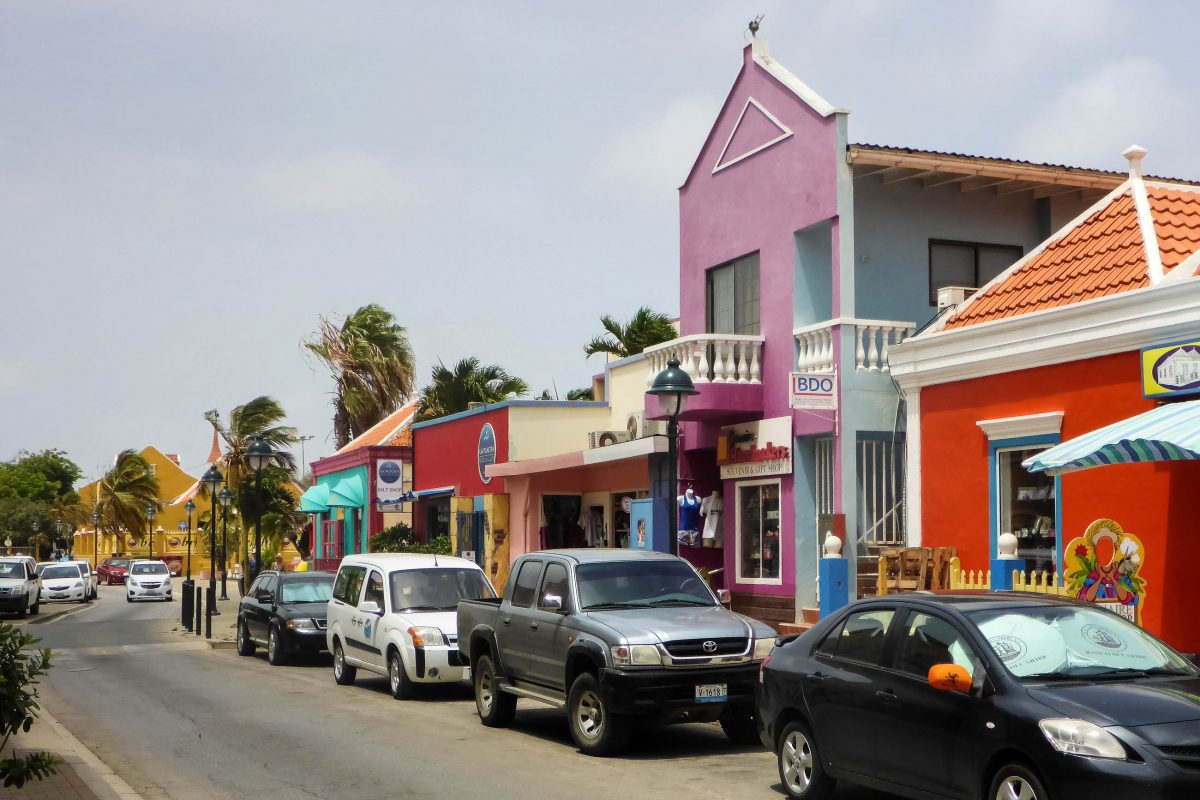
Kralendijk, die Hauptstadt von Bonaire, kann kaum als Stadt bezeichnet werden. Das ruhige Örtchen mit seinem zauberhaften Charme lockt mit einer Prise an Geschichte und Kultur und ist das perfekte Ziel für einen entspannten Abendausflug. Nette Cafés, die malerische Hafenstraße, das Fort Oranje, das Museum von Bonaire und die Flanierstraße Kaya Grandi zählen zu den nennenswerten Sehenswürdigkeiten von Kralendijk.
Artikel: Kralendijk
Fotogalerie: Kralendijk
Salzfelder und Flamingo Sanctuary von Pekelmeer

Die weitläufigen Salzfelder bei Pekelmeer im Süden Bonaires wurden ab 1968 zur Salzgewinnung angelegt und erstrecken sich über eine Fläche von 55 Hektar. Die unzähligen Tierchen in den Salzseen locken hungrige Flamingos an, die mit bis zu 40.000 Tieren eine der größten Flamingo-Kolonien der westlichen Hemisphäre bilden.
Die Salzfelder bei Pekelmeer schimmern in den brillantesten Farben unter der Sonne. Türkis leuchten die erst kürzlich gefluteten Salzpfannen, die bereits mit Garnelen bevölkerten Teiche schimmern in zarten Rosa- und Orangetönen und die trockengelegten Salzfelder und -dünen erstrahlen in grellem Weiß.
Auf dieser ohnehin schon prächtigen Kulisse staksen die majestätischen lachs- und orangefarbenen Flamingos in großen Gruppen durchs Wasser und laben sich an den reichlich vorhandenen Kleintieren in den Salzpfannen. Mit etwas Glück wird man Zeuge jenes Moments, an dem sich zig oder hunderte der eleganten Tiere in die Lüfte erheben und mit rauschenden Flügeln ihre Kreise ziehen – ein unvergesslicher Anblick!
Die Flamingos sind jedoch nicht die einzigen geflügelten Begleiter auf dem Weg durch das Pekelmeer Flamingo Sanctuary. Ornithologen erfreuen sich auch an Sichtungen von Fischadlern, Fregattvögeln, Reihern, Kormoranen, Regenpfeifern, Seeschwalben und anderen Seevögeln. Die Anzahl der tierischen Bewohner überwiegt in dieser einsamen Gegend eindeutig gegenüber der menschlichen.
Tipp: Um die farbenprächtigen Vögel in voller Größe bewundern und fotografieren zu können, sind gute Feldstecher oder Tele-Objektive gefragt; das Schutzgebiet darf von Besuchern nicht betreten werden und die tausenden Nistplätze sind von der Straße aus nicht sichtbar.
Willemstoren Leuchtturm
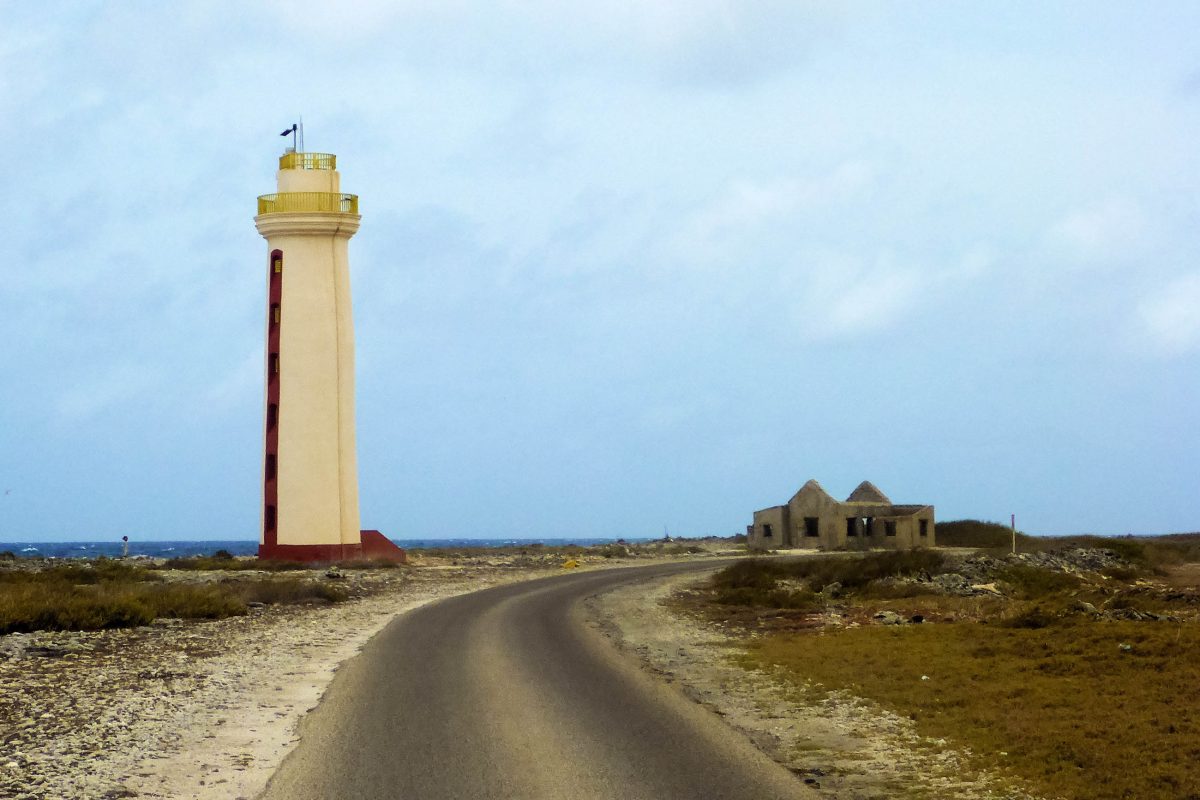
Als idealer Beobachtungsposten für die Vogelwelt bei Pekelmeer eignet sich der 20 Meter hohe Willemstoren Leuchtturm an der Südspitze von Bonaire. Der älteste Leuchtturm der Insel wurde am 24. August 1838, dem Geburtstag des niederländischen Königs Willem, in Betrieb genommen, nachdem die Leuchtfeuer, die von den Betreibern der Salzfelder entzündet wurden, die Schiffe nicht davon abhalten konnten, auf Grund zu laufen.
Rincon

Im 16. Jahrhundert war das von Spaniern gegründete Rincon die erste Siedlung auf Bonaire und ist heute neben Kralendijk die zweite offizielle Stadt der Insel. In den Cafés der geruhsamen Ortschaft kann man den Einheimischen lauschen, die gerne die wechselhafte Geschichte von Rincon erzählen. In den ruhigen Gassen des Städtchens trifft man nach wie vor mehr Ziegen und Esel als Autos.
Viele Häuser des Städtchens stammen noch aus historischen Zeiten und manche von ihnen wurden bereits liebevoll restauriert. Das Herz von Rincon markiert die unübersehbare, gelb und weiß getünchte Ludovicus Bertrandus Kerk aus dem Jahr 1908. Ansonsten fallen vor allem die Kaktuszäune ins Auge, die nicht nur vor lästigen Blicken schützen, sondern auch diverse Haustiere, von der Katze bis zur Kuh, sehr effektiv an der Flucht hindern.
Die Besiedlung Bonaires kann archäologischen Funden zufolge bis um 900 vor Christus zurückverfolgt werden. Nach der Entdeckung von Bonaire durch Amerigo Vespucci im Jahr 1499 wurden alle Ureinwohner der Insel nach Hispaniola (heute Dominikanische Republik und Haiti) verfrachtet, um dort in den Kupferminen zu arbeiten.
Knapp 30 Jahr später kamen die Spanier zurück nach Bonaire und gründeten im Jahr 1527 in einem fruchtbaren Tal ihre erste Siedlung: Rincon. Im Jahr 1636 weitete die West India Company, die schon lange auf der Nachbarinsel Curaçao vertreten war, ihren Anspruch auch auf Bonaire aus und die Niederländer schätzten die Insel aufgrund ihres Bauholzes und ihrer reichen Salzvorkommen.
Die blühende Wirtschaft auf Bonaire brachte Sklaven auf die Insel, die sich ebenfalls in Rincon ansiedelten und auf den Plantagen der Umgebung sowie auf den Salzfeldern bei Pekelmeer arbeiteten. 1863 wurde die Sklaverei auf Bonaire abgeschafft und viele der ehemaligen Sklaven blieben in Rincon, wo zum Großteil noch heute ihre Nachkommen anzutreffen sind.
Offizielle Website von Rincon auf Bonaire
Sklavenhütten bei Pekelmeer
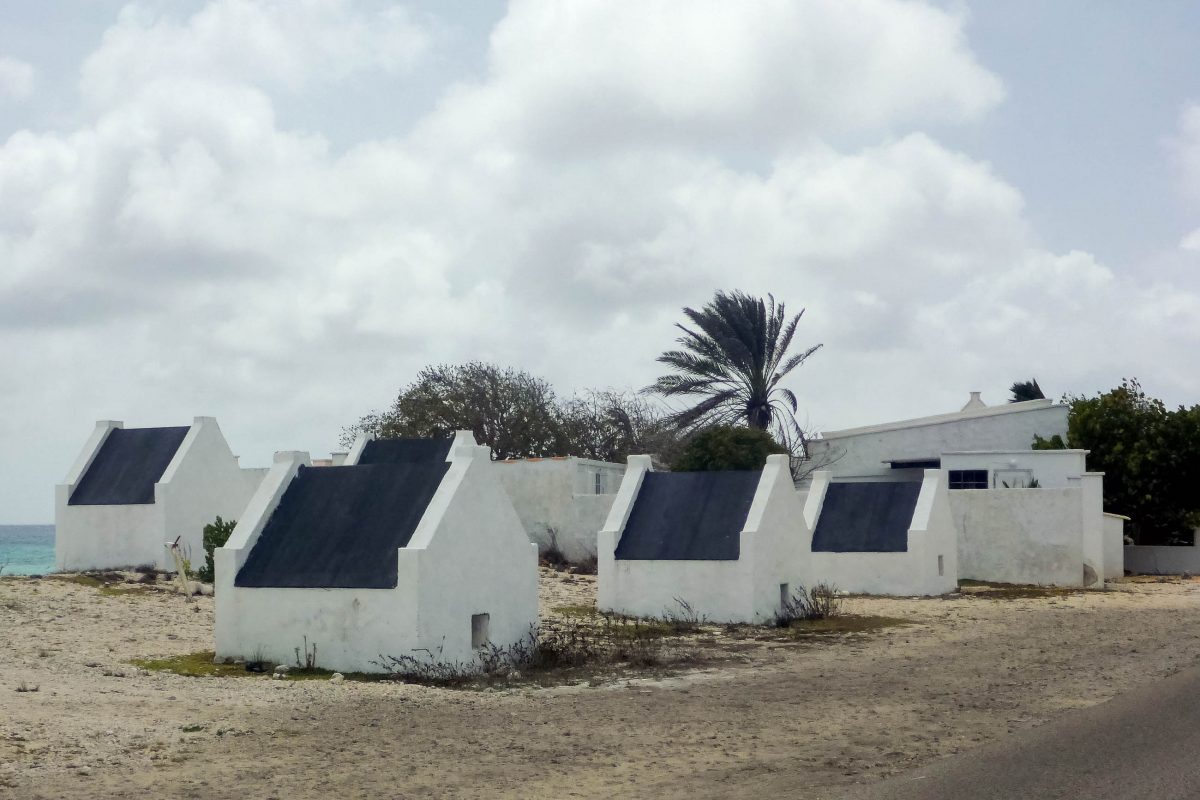
Auch die 1992 im Auftrag der STINAPA restaurierten Sklavenhütten bei Pekelmeer erzählen von der traurigen Vergangenheit der Sklaverei auf Bonaire. Hier lebten früher die Sklaven, die in der Umgebung und unter anderem auf den Salzfeldern von Pekelmeer arbeiteten. Von Rincon, wo die meisten Sklaven lebten, waren diese zehn Gehstunden entfernt, und so wurden um die Salzpfannen mehrere winzige Hütten errichtet, die zu Anfang noch aus Lehm und Stroh und ab 1850 aus Stein waren.
Die kleinen Häuschen in weiß und orange mögen idyllisch aussehen, waren mit einer Grundfläche von 2×2 Meter jedoch kaum größer als Hundehütten und beherbergten früher bis zu drei Sklaven. Unglaublich, unter welch skandalösen Lebensbedingungen die Menschen damals gehalten wurden. Die beiden Tauch-Spots „Red Slave“ und „White Slave“ sind nach der jeweiligen Farbe der Sklavenhütten benannt.
Washington Slagbaai Nationalpark

Ein Fünftel von Bonaire wird vom Washington Slagbaai Nationalpark eingenommen. Das größte zusammenhängende Schutzgebiet der Antillen liegt im Norden der Insel und bietet über 130 Vogelarten einen sicheren Lebensraum.
Zwischen Riesen-Kakteen und Divi-Divi-Bäumen leben Papageien, Sittiche und Flamingos, Strände laden zum Sonnenbaden und Schwimmen ein und die höchste Erhebung von Bonaire bietet eine fantastische Aussicht über die Insel und das Meer.
Artikel: Washington Slagbaai Nationalpark




